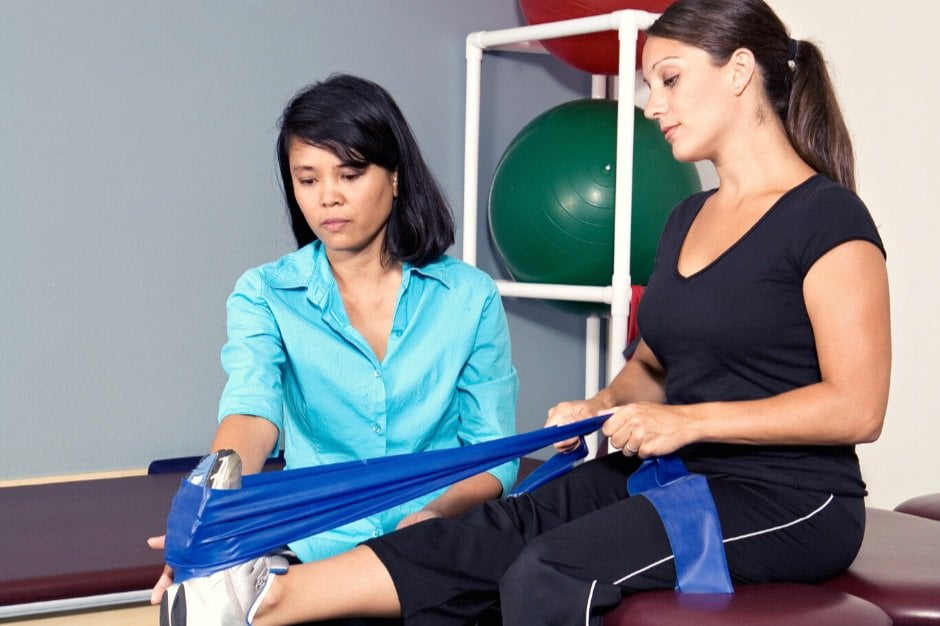Multiple Sclerosis (MS) is a chronic neurological disease characterized by unpredictable episodes of nerve dysfunction. While there is no known cure for MS, there are many ways to manage its symptoms and improve the quality of life for those diagnosed. One such method is physical therapy. So, this blog delves into the importance of physical therapy for multiple sclerosis and provides insights into how it can create a positive impact.
Contents
Understanding Multiple Sclerosis
 Multiple Sclerosis (MS) is a chronic autoimmune disorder affecting the central nervous system, specifically targeting the brain and spinal cord. Within this system, the protective myelin sheath that covers nerve fibers becomes damaged. This leads to communication problems between the brain and the rest of the body. Over time, the disease can cause the nerves to deteriorate or become permanently damaged.
Multiple Sclerosis (MS) is a chronic autoimmune disorder affecting the central nervous system, specifically targeting the brain and spinal cord. Within this system, the protective myelin sheath that covers nerve fibers becomes damaged. This leads to communication problems between the brain and the rest of the body. Over time, the disease can cause the nerves to deteriorate or become permanently damaged.
The exact cause of MS remains unknown. But it’s believed to be a combination of genetic and environmental factors. Symptoms vary widely among patients and can range from fatigue, numbness, and vision problems to more severe conditions such as muscle paralysis and loss of coordination. Due to its unpredictable nature, each MS diagnosis and progression is unique. Therefore, it requires personalized care and management strategies.
What Kind Of Physical Therapy Is Used For Multiple Sclerosis?
Physical therapy for Multiple Sclerosis (MS) is tailored to the individual needs of the patient, considering the stage of the disease, the specific symptoms they are experiencing, and their personal goals. Here’s a breakdown of the types of physical therapy for Multiple Sclerosis:
- Stretching Exercises
These can help reduce muscle stiffness, which is common in MS. Regular stretching can also prevent or decrease muscle shortening and improve overall functional ability.
- Strengthening Exercises
MS can lead to muscle weakness. So resistance and weight-bearing exercises can be beneficial. These exercises help in maintaining or improving muscle strength, which can enhance mobility and reduce the risk of falls.
- Balance and Coordination Training
Due to demyelination, individuals with MS often face challenges with balance and coordination. Physical therapists use specific exercises and activities to enhance these skills, helping to reduce the risk of falls and improve overall functional mobility.
- Gait Training
For those with MS who experience difficulty walking, physical therapists can offer gait training. This can involve techniques to improve walking patterns, the use of assistive devices like canes or walkers, and strategies to conserve energy.
- Aerobic Conditioning
Low-impact aerobic exercises, such as walking, stationary cycling, or aquatic exercises. All of this can help improve cardiovascular fitness, combat fatigue, and improve mood.
- Functional Training
This is about helping patients perform daily activities, like dressing or cooking, more efficiently and safely. It might involve teaching energy conservation techniques or using adaptive equipment.
- Neuromuscular Stimulation
In some cases, electrical stimulation may be used to enhance muscle strength and function, especially if certain muscles are significantly weakened.
- Pain Management Techniques
This can include manual therapy, stretching, or modalities like heat, cold, or ultrasound to manage spasticity, muscle pain, or other discomforts associated with MS.
- Energy Conservation Techniques
Since fatigue is a significant concern for many with MS, therapists often provide strategies to conserve energy throughout the day, ensuring that patients can complete essential tasks without becoming overly fatigued.
Regular assessment is crucial as MS symptoms can fluctuate. The physical therapist will modify the therapy plan according to the changing needs and conditions of the patient.
What Is The Best Exercise For Multiple Sclerosis?
 It’s essential to understand that the “best” exercise for someone with Multiple Sclerosis (MS) varies based on their individual symptoms, progression of the disease, and overall fitness level. However, some exercises have been found particularly beneficial for many individuals with MS.
It’s essential to understand that the “best” exercise for someone with Multiple Sclerosis (MS) varies based on their individual symptoms, progression of the disease, and overall fitness level. However, some exercises have been found particularly beneficial for many individuals with MS.
Here are five such exercises, along with instructions:
Seated Leg Stretch (Hamstring Stretch)
- Sit at the edge of a chair, with one foot flat on the ground.
- Extend the other leg straight out in front, keeping the heel on the floor and toes pointing up.
- Keeping your back straight, lean forward slightly until you feel a stretch in the back of your extended leg.
- Hold for 20-30 seconds, then switch legs.
Wall Push-Ups
- Stand about two feet away from a wall, facing it.
- Place your palms flat against the wall at shoulder height, shoulder-width apart.
- Bend your elbows and lean towards the wall.
- Push yourself back to the starting position using your arms.
- Repeat 10-15 times.
Ankle Circles
- Sit comfortably in a chair.
- Lift one foot off the ground and rotate your ankle in a circular motion.
- Do 10-15 circles in one direction and then reverse the direction for another 10-15 circles.
- Repeat with the other ankle.
Hip Bridges
- Lie flat on your back with your knees bent and feet flat on the floor, hip-width apart. Place your arms by your sides, palms facing down.
- Pressing through your heels, lift your hips off the ground by squeezing your glutes. Your body should form a straight line from your shoulders to your knees at the top of the movement.
- Hold for a few seconds, then slowly lower your hips back to the floor.
- Repeat 10-15 times.
Seated Marching
- Sit tall in a chair with your feet flat on the ground.
- Keeping your back straight, lift one knee towards your chest, then lower it back to the ground.
- Alternate legs as if you’re marching.
- Continue for 1-2 minutes.
It’s crucial for individuals with MS to consult with a physical therapist or medical professional before starting any exercise routine. They can provide guidance tailored to the individual’s specific needs and ensure exercises are done safely and effectively.
Why Is Massage Good For MS?
Massage therapy can offer a range of benefits for individuals with Multiple Sclerosis (MS). It is primarily centered around symptom management and overall well-being. For many MS patients, muscle stiffness or spasticity is a persistent issue, often leading to discomfort, reduced mobility, and pain. Massage can help alleviate this stiffness by promoting relaxation of the muscles and improving circulation to the affected areas.
The increased blood flow can help nourish tissues, potentially aiding in muscle repair and reducing the frequency or severity of muscle spasms. Additionally, massage can aid in the release of endorphins, the body’s natural painkillers. This can be especially beneficial for MS patients who experience chronic pain.
Beyond the direct physical benefits, massage therapy also addresses the psychological and emotional aspects of living with MS. The soothing nature of a massage can promote relaxation and reduce stress, offering a reprieve from the challenges of daily life with the disease. Reducing stress is particularly crucial for MS patients, as stress can exacerbate symptoms.
The holistic approach of massage therapy—targeting physical, emotional, and mental well-being—makes it a valuable complementary therapy for those living with MS.
How To Make The Most Out Of Your Sessions?
 Making the most out of any session, whether it’s a therapy appointment, a workout, a class, or a professional meeting, involves preparation, presence, and reflection. Here are some guidelines to help you maximize the benefits of your sessions:
Making the most out of any session, whether it’s a therapy appointment, a workout, a class, or a professional meeting, involves preparation, presence, and reflection. Here are some guidelines to help you maximize the benefits of your sessions:
- Set Clear Objectives: Before the session, define what you want to achieve. Whether it’s a specific question you want answered, a skill you want to learn, or an issue you want to discuss, having a clear goal can guide the session’s flow.
- Arrive Early and Prepared: Being punctual shows respect for the other party’s time. Also, arriving a few minutes early allows you to mentally prepare, gather your thoughts, and review any necessary materials.
- Minimize Distractions: Silence or turn off notifications on your phone and other devices. If you’re in a virtual meeting or class, find a quiet space where you’re unlikely to be interrupted.
- Engage Actively: Participation is key. Ask questions, share your thoughts, and be involved in discussions. Active involvement helps in better understanding and retention.
- Take Notes: Jotting down key points, insights, or follow-up tasks ensures you remember them later. It’s also a good reference for future sessions.
- Practice Active Listening: Instead of formulating your next question or comment, truly listen to what the other person is saying. This deepens understanding and fosters better communication.
- Stay Open-minded: Being receptive to new ideas or feedback, even if it challenges your current beliefs, can lead to personal and professional growth.
- Reflect After the Session: Once the session concludes, spend a few minutes reviewing your notes and reflecting on what you learned. This can help solidify new knowledge and identify areas for further exploration.
- Implement and Practice: If you’ve learned a new technique or received advice, try to implement it in your daily life or work. Practice helps in mastering new skills or habits.
- Stay Consistent: Regular attendance or participation, especially in therapy or classes, builds on previous sessions and leads to more significant progress over time.
Lastly, always remember that every session is a learning opportunity. Even if things don’t go exactly as planned, there’s always something to be gained, whether it’s new knowledge, a different perspective, or insight into areas for improvement.
Conclusion
In the ever-evolving journey of managing and living with Multiple Sclerosis (MS), incorporating strategies such as physical therapy and massage offers promising avenues for enhancing overall well-being. From the tailored exercises that address specific physical challenges to the soothing benefits of a therapeutic massage, these treatments can make a significant difference in symptom management and quality of life.
As with all aspects of MS care, the key lies in personalization and active engagement—understanding one’s body, setting clear goals for each session, and maximizing the benefits through consistent practice and reflection. Physical Therapy helps patients recover from pain. If you’re experiencing Back, Shoulder, Knee, Neck, Elbow, Hip, or Arthritis pain, a physical therapist at PhysioMantra can help: Book an online physical therapy session.



